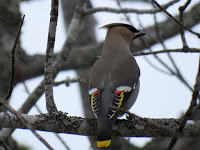BOHEMIAN WAXWING
BOHEMIAN WAXWING (Bombycilla garrulus) – (See images below)
DESCRIPTION: The Bohemian Waxwing is a plump bird with mostly grey plumage, and distinctive waxy red tips on some wing feathers (hence the name). It has a mostly flat head crest, a black mask around the eyes and a black throat. The tail ends with a yellow band. There are black markings on the wings. The rump is cinnamon. The short bill is black and the legs are grey. The feathers look very fine. Sexes are similar. This bird is around 18 cm (7 inches) long.
VOICE: https://www.xeno-canto.org/species/Bombycilla-garrulus
NAME: The English name ‘Waxwing’ refers to the bright red tips of some of the bird’s wing feathers. As for the name ‘Bohemian’, The Latin genus name ‘Bombycilla’ comes from Greek and means ‘silky tail’, in reference to the soft plumage of the bird. The Latin species name ‘garrulus’, means ‘chattering’, because this bird was compared to the noisy European Jay (Garrulus glandarius) in terms of appearance.
HABITAT: Forests of different types in the summer, more open forests in the winter, including urban areas with fruit bearing trees and shrubs.
DIET: In the summer, mostly insects, sometimes caught on the fly. In the winter, berries.
NESTING: The nest is built in a tree, preferably a conifer. It is built by both parents from twigs and lined with finer material. An average of five light grey-blue eggs are laid, which are incubated by the female for the most part. Both parents feed the young.
DISTRIBUTION: This waxwing species is found mainly in the coniferous forests of the northern hemisphere for the breeding season, and migrates (at times irruptively) south of that range in search of winter berries.
DISTRIBUTION MAP: https://en.wikipedia.org/wiki/Bohemian_waxwing#/media/File:Bombycillagarrulusmap2.png
ON PEI: The Bohemian waxwing does not breed on Prince Edward Island. It is mostly an irregular visitor, usually in the winter.
CONSERVATION: Thanks to their wide range and large numbers, Bohemian waxwings are not considered at risk.
NOTES: The Bohemian waxwing is an ‘irruptive’ species. This means that they form large flocks to feed on berries left on shrubs in the winter, for example the winterberry (see photo below).
SIMILAR SPECIES: Cedar Waxwing – Here’s an article to help distinguish between the two species.
REFERENCES: https://www.borealbirds.org/bird/bohemian-waxwing
https://www.allaboutbirds.org/guide/Bohemian_Waxwing/id
https://en.wikipedia.org/wiki/Bohemian_waxwing
https://identify.whatbird.com/obj/740/_/Bohemian_Waxwing.aspx
https://www.audubon.org/field-guide/bird/bohemian-waxwing
https://www.birdscalgary.com/tag/bohemian-waxwing/
DESCRIPTION: The Bohemian Waxwing is a plump bird with mostly grey plumage, and distinctive waxy red tips on some wing feathers (hence the name). It has a mostly flat head crest, a black mask around the eyes and a black throat. The tail ends with a yellow band. There are black markings on the wings. The rump is cinnamon. The short bill is black and the legs are grey. The feathers look very fine. Sexes are similar. This bird is around 18 cm (7 inches) long.
VOICE: https://www.xeno-canto.org/species/Bombycilla-garrulus
NAME: The English name ‘Waxwing’ refers to the bright red tips of some of the bird’s wing feathers. As for the name ‘Bohemian’, The Latin genus name ‘Bombycilla’ comes from Greek and means ‘silky tail’, in reference to the soft plumage of the bird. The Latin species name ‘garrulus’, means ‘chattering’, because this bird was compared to the noisy European Jay (Garrulus glandarius) in terms of appearance.
HABITAT: Forests of different types in the summer, more open forests in the winter, including urban areas with fruit bearing trees and shrubs.
DIET: In the summer, mostly insects, sometimes caught on the fly. In the winter, berries.
NESTING: The nest is built in a tree, preferably a conifer. It is built by both parents from twigs and lined with finer material. An average of five light grey-blue eggs are laid, which are incubated by the female for the most part. Both parents feed the young.
DISTRIBUTION: This waxwing species is found mainly in the coniferous forests of the northern hemisphere for the breeding season, and migrates (at times irruptively) south of that range in search of winter berries.
DISTRIBUTION MAP: https://en.wikipedia.org/wiki/Bohemian_waxwing#/media/File:Bombycillagarrulusmap2.png
ON PEI: The Bohemian waxwing does not breed on Prince Edward Island. It is mostly an irregular visitor, usually in the winter.
CONSERVATION: Thanks to their wide range and large numbers, Bohemian waxwings are not considered at risk.
NOTES: The Bohemian waxwing is an ‘irruptive’ species. This means that they form large flocks to feed on berries left on shrubs in the winter, for example the winterberry (see photo below).
SIMILAR SPECIES: Cedar Waxwing – Here’s an article to help distinguish between the two species.
REFERENCES: https://www.borealbirds.org/bird/bohemian-waxwing
https://www.allaboutbirds.org/guide/Bohemian_Waxwing/id
https://en.wikipedia.org/wiki/Bohemian_waxwing
https://identify.whatbird.com/obj/740/_/Bohemian_Waxwing.aspx
https://www.audubon.org/field-guide/bird/bohemian-waxwing
https://www.birdscalgary.com/tag/bohemian-waxwing/
 |
| Bohemian waxwing, PEI, Matt Beardsley |
 |
| Bohemian waxwing, PEI, by Sandra Meade |
 |
| Bohemian waxwings over winterberry PEI, by Don Jardine |